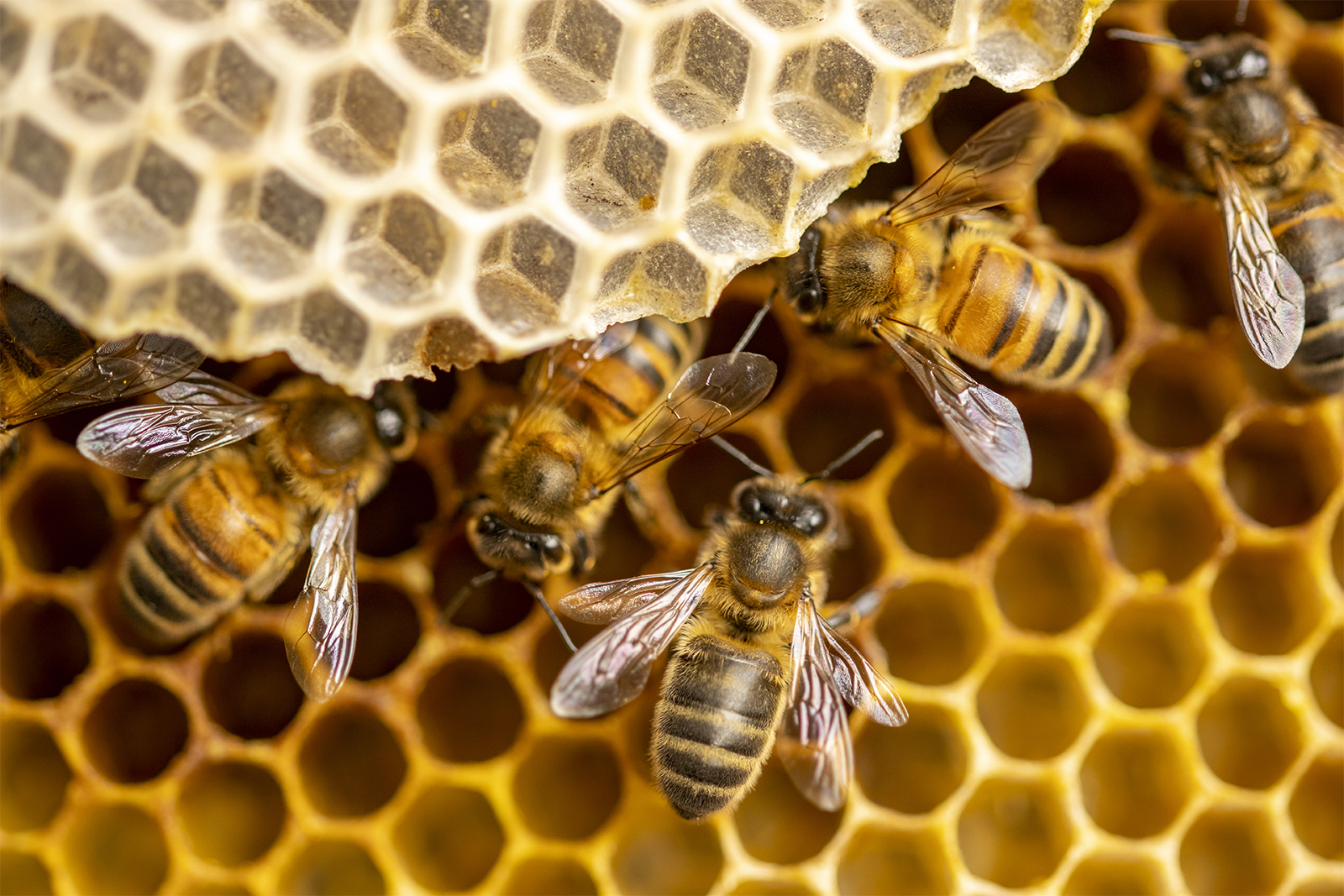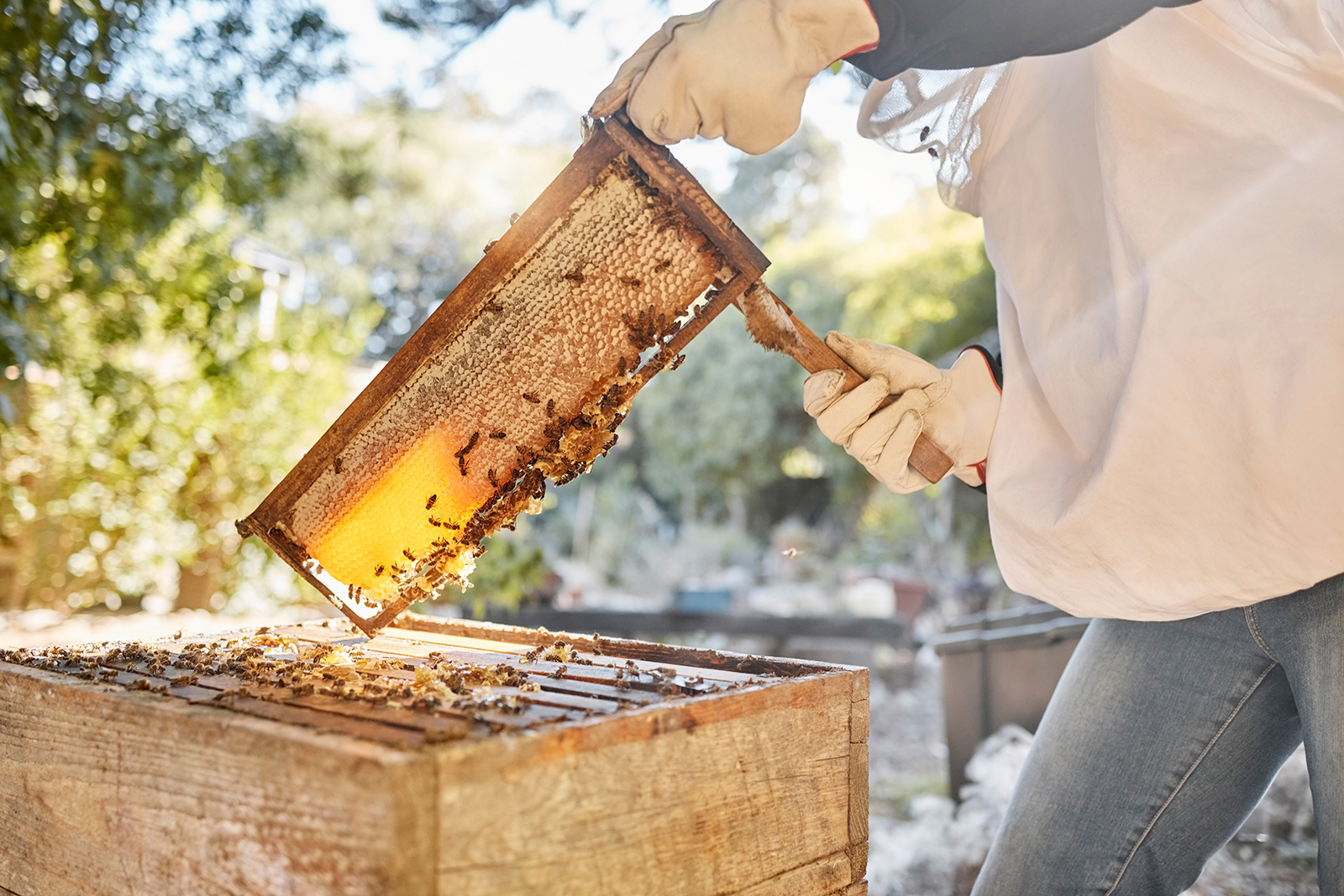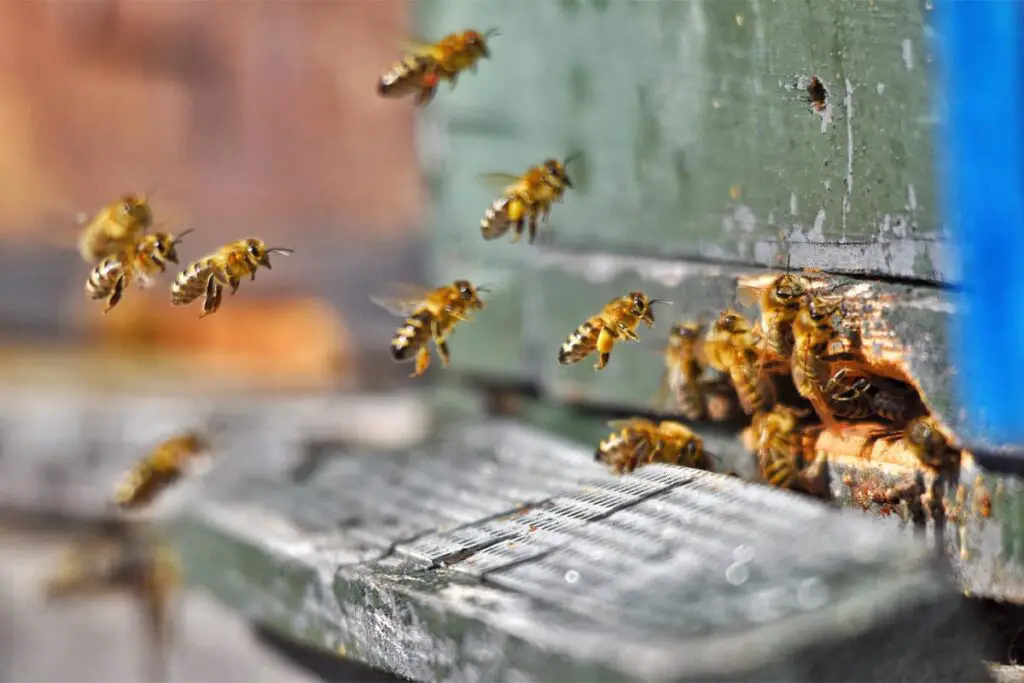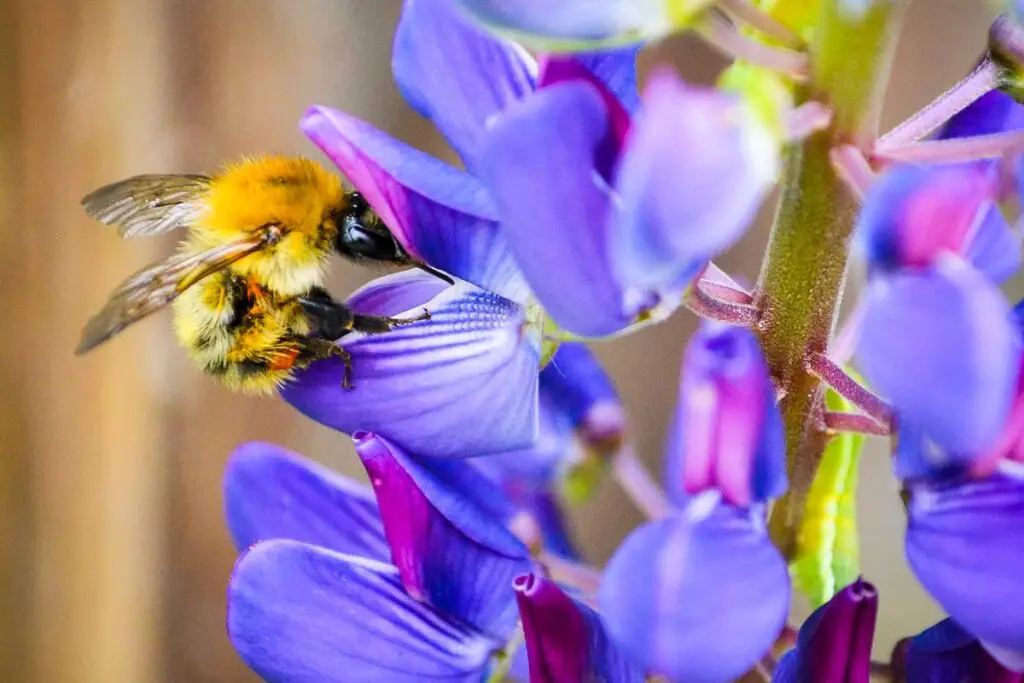
One interesting question I’ve noticed coming up from time to time online is ‘why do bees make honey if they don’t actually eat it themselves?’
The answer to this one is surprisingly simple: Bees can and do eat honey – just not right away!
The primary purpose of honey production is to serve as a food source for the bees during the winter months when there are no flowers blooming and no nectar available for the bees to feed on. This vital food supply is stored by the bees in their hives and consumed by them to survive through the cold season.
Another interesting aspect of honey production is the role it plays in communication among the bees. In fact, the honey-making process is an extraordinary example of cooperation and teamwork within the bee colony.
I dug a little deeper, I found out that bees use the honey as a way to communicate with each other and share information about the best sources of nectar, among other things. This incredibly valuable resource not only sustains the bees but also supports the intricate social structure within the colony.
So, while it might seem strange to us that bees make something they don’t immediately consume, a closer look reveals that honey is an essential part of the bees’ survival and society. The fact that humans can also enjoy this sweet product is a lucky bonus, but the production of honey is truly centered around the needs and functioning of the bee colony itself.
The Primary Function of Honey
Honeybees make honey to store food for their colony to help them survive the harsh winter months when there are fewer flowers to obtain nectar from. This is an essential task for the hive because it ensures they colony has a sufficient food supply when resources become scarce.
Worker bees collect nectar using their long, thin tube-like proboscis to suck it up from flowers. They then store the nectar in their specialized honey stomach, known as the crop, which can hold up to 80% of their weight in nectar. This nectar undergoes a transformative process involving enzymes, allowing it to ultimately become honey.
During honey production a single bee may need to visit over 1,000 flowers before their honey stomach is completely full, after which they return to the hive and pass the nectar to other worker bees for further processing (Live Science). The bees’ teamwork and efficient food storage system make the honey-making process smooth and successful for their colony’s survival.
What Bees Eat
Larvae Diet
The diet of bee larvae mainly consists of pollen. This provides protein and essential nutrients required for their growth and development. The high protein content in pollen makes it a suitable food source for young bees (LearnBees). In addition to pollen, bee larvae sometimes consume a mix of honey and pollen called bee bread, which provides them with an energy-dense source of nutrients.
Adult Bees Diet
Adult bees, on the other hand, have a diet mostly comprising of nectar and pollen. Nectar serves as the primary source of carbohydrates, supplying bees with energy, while pollen is essential for their protein intake. These two components work together to provide bees with a well-balanced and complete diet. Specifically, during winter months, bees consume stored honey as their main food source, as they cannot forage for nectar outdoors (WorldAtlas).
Bees’ diets vary based on their life stage. Larvae rely more on protein-rich pollen, while adult bees consume a combination of nectar and pollen for a balanced diet.
The Role of Worker Bees
Worker bees play an essential role within the colony. One of their primary tasks is to make honey, which might seem counterintuitive since they don’t eat it themselves. Instead, they create honey for the benefit of the colony as a whole. In this section I’d like to quickly cover the different tasks the workers perform, specifically focusing on foraging, processing nectar, and storing honey.

Foraging
A worker bees’ main responsibility outside of the hive is to collect nectar from flowers. This sweet liquid is the primary source of raw material needed to make honey. They use a long, thin tube called a proboscis to suck up the nectar and store it in their honey stomach, which is separate from my regular digestive system (Bee Culture). While they’re out foraging they also help with the pollination process by spreading pollen between flowers, a critical step in the reproduction of plants.
Processing Nectar
Once the worker has collected nectar and returned to the hive they begin the process of turning the nectar into honey. Inside their honey stomach, enzymes break down the complex sugars in the nectar into simpler sugars, which makes honey more stable and resistant to spoilage (Bee Culture). They then transfer the partially processed nectar to another worker bee, who continues the process by adding more enzymes and reducing the water content. This process is repeated several times among multiple worker bees.
Storing Honey
After the nectar has been processed into honey, it’s time for the worker bees to store it in the honeycomb, which is constructed of hexagonal cells made from beeswax. They deposit the honey into these cells and then fan their wings over it, helping to evaporate any remaining water content (Carolina Honeybees). Once the honey has reached its optimal moisture content they seal off the honeycomb cell with a wax cap. This honey serves as a primary food source for the colony, providing essential energy and nutrition during times when foraging isn’t possible.
Honey as a Food Source
While it’s a common misconception that bees don’t consume honey, the truth is that they create honey as a valuable food source not just for themselves, but also for the entire colony.
Surviving Winter
In the winter months, there is a scarcity of flowers, making it difficult for bees to find nectar. As a result, bees rely on the honey they’ve stored throughout the warmer months as a means of sustenance during these periods of nectar scarcity. This stored honey provides them with the energy and nutrients they need to survive until the flowers start blooming again in spring.
Supporting the Colony
Honey not only plays a crucial role in helping bees survive the winter, but it also serves as an essential source of energy and nutrients for the colony throughout the year. Bees break down the sugars in nectar into carbohydrates, providing them with the energy required for foraging and other activities. In the absence of nectar, bees will consume their stored honey to keep their metabolism running optimally (BeehiveHero).
Additionally, honey is essential for the proper development of young bees within the colony. The honey is fed to larvae, ensuring they receive the necessary nutrients to grow into healthy adult bees. The consumption of honey also aids in communication within the colony, as bees use the information stored within honey to interact with one another (BeeRaw).
Honeybee Communication
In my journey to understanding bees I discovered that honeybee communication is a fascinating and integral aspect of their lives. They have intricate methods to share information about foraging and organizing their hive. Two primary ways they communicate include the waggle dance and the use of pheromones.
The Waggle Dance
Bees use a fascinating behavior called the waggle dance to inform their fellow hive members about the location of valuable resources like nectar and pollen. The dance primarily consists of figure-eight patterns, in which the bee waggles its abdomen while moving in a straight line. The angle, duration, and speed of this dance provide specific information about the direction and distance of the resource in relation to the sun’s position.
For instance, if the straight-line portion of the dance is performed at a 90-degree angle to the vertical, it informs the observers that the resource is 90 degrees to the right of the sun. Additionally, the duration of the waggling helps the bees estimate the distance to the resource. A longer waggling portion indicates a greater distance to be covered.
The Role of Pheromones
Another essential aspect of honeybee communication is the use of pheromones. Pheromones are chemical substances released by bees that serve as messages to other members of the hive. These chemicals can influence many aspects of the hive’s functioning, such as foraging, defense, and reproduction.
- Queen pheromones: The queen bee releases specific pheromones that help maintain order in the hive. The presence of queen pheromones suppresses the development of ovaries in the worker bees, ensuring that she remains the only reproductive female.
- Foraging pheromones: When a worker bee identifies a good source of nectar or pollen, it releases a foraging pheromone to attract other workers to that location. This pheromone greatly assists in the efficient collection of resources for the hive’s survival.
- Alarm pheromones: In the event of a threat to the hive, bees release alarm pheromones that inform their fellow hive members about the danger. This prompts them to take immediate action in defending their home.
Both the waggle dance and the use of pheromones show that honeybees have an incredible ability to communicate efficiently and effectively. These intricate communication strategies enable them to work together and gather the necessary resources for survival.
Honey Production and Human Consumption
As both an insect and honey enthusiast, I used to wonder about the reasons behind honey production in bees and how this impacts human consumption. Here are some insights I’ve gained from my research into the topic.
Beekeeping Practices
In order to produce honey, bees collect nectar from flowers and mix it with enzymes in their salivary glands. This mixture is then stored in the honeycomb, where it undergoes the process of evaporation to create the thick, golden substance we know as honey. This natural process has been followed by beekeepers for centuries, as they collect the excess honey produced by bees for human use. However, it’s essential that beekeepers maintain responsible practices, as harvesting honey without providing bees an alternative food source can lead to starvation and the loss of the colony.

Sustainability
As a consumer, it’s crucial for me to understand the implications of honey production on the sustainability of both bees and the environment. I’ve learned that honey production can be sustainable if done responsibly. This involves allowing bees to retain an adequate amount of honey for their own use while collecting only the excess for human consumption. In doing so, it’s possible to enjoy honey without endangering the health and well-being of the bee population.
Environment
Beyond the direct relationship between bees and honey production, I’ve discovered that bees play a vital role in maintaining the balance of our ecosystem. As pollinators, bees contribute to the survival of various plant species, which in turn supports a diverse range of animal life, including birds, insects, and other mammals. This interconnectedness between honey production and ecological balance only reinforces the importance of sustainable beekeeping practices and responsible honey consumption by humans.
As an individual who enjoys my honey on toast, I believe it’s important to be aware of the reasons behind honey production in bees and the implications for human consumption. By understanding and appreciating these factors, we can make informed decisions to support sustainable and responsible honey production practices.
Conclusion
Bees make honey primarily as a food source for their colony during the winter months, when there are fewer flowers available for them to collect nectar. I learned that even though they don’t eat honey themselves, they rely on it to provide energy and nutrients to other members of their hive. This information has been confirmed through various sources.
I’ve gained a deeper appreciation for the role bees play in our ecosystem, not only as pollinators, but also as providers for their colonies. Their tireless work ensures that they have enough honey stored to sustain the hive throughout the winter. It’s fascinating to think about the complex processes these small insects have developed in order to survive and thrive.
In light of this, I’m reminded of the importance of protecting bee populations and their habitats. By understanding why bees make honey and the essential functions it serves in their lives, I believe we can further appreciate the need to conserve and support these incredible creatures, contributing to the overall health of our environment and planet.
Driven by a passion for those tiny creatures that rule our world, we at Bug Domain strive to be your go-to resource for information on insects.



